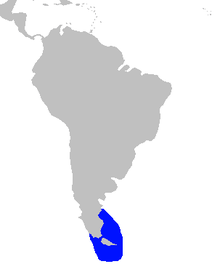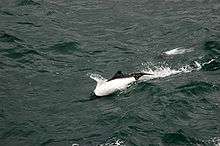Commerson's dolphin
| Commerson's dolphin[1] | |
|---|---|
 | |
| A Commerson's dolphin in an aquarium. | |
 | |
| Size compared to an average human | |
| Scientific classification | |
| Kingdom: | Animalia |
| Phylum: | Chordata |
| Class: | Mammalia |
| Order: | Artiodactyla |
| Infraorder: | Cetacea |
| Family: | Delphinidae |
| Subfamily: | Cephalorhynchinae |
| Genus: | Cephalorhynchus |
| Species: | C. commersonii |
| Binomial name | |
| Cephalorhynchus commersonii Lacépède, 1804 | |
| Subspecies | |
| |
 | |
| C.c.commersonii distribution near South America | |
 | |
| C.c.kerguelensis distribution near the Kerguelen Islands | |
Commerson's dolphin (Cephalorhynchus commersonii), also referred to by the common names skunk dolphin, piebald dolphin or panda dolphin, is a small oceanic dolphin of the genus Cephalorhynchus. Commerson's dolphin has two geographically-isolated but locally-common subspecies. The principal subspecies, C.c.commersonii, has sharply-delineated black-and-white patterning and is found around the tip of South America. The secondary subspecies, C.c.kerguelenensis, is larger than C.c.commersonii, has a less-sharply delineated dark and light grey patterning with a white ventral band, and is found around the Kerguelen Islands in the Indian Ocean.
The dolphin is named for French naturalist Dr Philibert Commerson, who first described them in 1767 after sighting them in the Strait of Magellan.[3]
Population and distribution
Two disjunct subspecies of the dolphin are found in geographically disparate areas separated by 130° of longitude and about 8,500 km (5,300 mi); it is not known why they are thus distributed. Global populations are unknown, but the species is accepted to be locally common.
The main subspecies, C.c.commersonii, is found inshore in various inlets in Argentina including Puerto Deseado, in the Strait of Magellan and around Tierra del Fuego, and near the Falkland Islands. A survey in 1984 estimated there to be 3,400 individuals in the Strait of Magellan.
Dolphins of the second subspecies, C.c.kerguelenensis, were discovered in the 1950s. They reside near the Kerguelen Islands in the southern part of the Indian Ocean, and prefer shallow waters.
In 2004, a vagrant individual of unconfirmed origin was sighted on South Africa's Agulhas Bank, a location 4,200 km (2,600 mi) from the Kerguelen Islands and 6,300 km (3,900 mi) from South America. Though the Kerguelen Islands are closer, such a journey would require swimming against the Antarctic Circumpolar Current.[4]
Description
C.c.commersonii

The commersonii subspecies has a black head, dorsal fin, and fluke, with a white throat and body. The demarcation between the two colours is very clear-cut. This stocky creature is one of the smallest of all cetaceans, growing to around 1.5 m (5 ft). A mature female caught off of southern Patagonia, at 23 kg (51 lb) and 1.36 m (4.5 ft), may be the smallest adult cetacean on record.[5] Its appearance resembles that of a porpoise, but its conspicuous behaviour is typical of a dolphin. The dorsal fin has a long, straight leading edge which ends in a curved tip. The trailing is typically concave but not falcate. The fluke has a notch in the middle. This dolphin has no rostrum (beak).
Sexes are easily distinguished by the different shape of the black blotch on the belly — it is shaped like a teardrop in males but is more rounded in females. Females reach breeding age at six to 9 years. Males reach sexual maturity at about the same age. Mating occurs in the spring and summer and calving occurs after a gestation period of 11 months. The Commerson's dolphin has been known to live up to eighteen years in the wild, while in captivity the oldest individual was at least 33 years old at the time of death.[6]
C.c.kerguelenensis
Dolphins of the kerguelenensis subspecies tend to be larger than those of C.c.commersonii, and differ in patterning in that they are dark grey instead of black, and light grey instead of white, except ventrally. The demarcation between areas of the pattern is also less clearly demarcated.[7]
Behavior
Commerson's dolphin is very active. It is often seen swimming rapidly on the surface and leaping from the water. It also spins and twists as it swims and may surf on breaking waves when very close to the shore. It will bow-ride and swim behind fast-moving boats. It is also known to swim upside-down, which is thought to improve the visibility of its prey.
This dolphin feeds on a mix of coastal and pelagic fish and squid. Those in the South American subpopulation supplement their diets with crustaceans.
Conservation
The IUCN lists Commerson's dolphin as Data Deficient in its Red List of Threatened Species. The proximity of the dolphin to the shore makes accidental killing in gillnets a common occurrence. The dolphin was killed for use as crab bait by some Argentinian and Chilean fishermen in the 1970s and 1980s, but this practice has since been curtailed.[2]
The Commerson's dolphin population of South America is listed on Appendix II[8] of the Convention on the Conservation of Migratory Species of Wild Animals (CMS). It is listed on Appendix II[8] as it has an unfavourable conservation status or would benefit significantly from international co-operation organised by tailored agreements.[9]
Captivity
About two dozen Commerson's dolphins live in aquariums around the world.
See also
References
| Wikimedia Commons has media related to Cephalorhynchus commersonii. |
| Wikispecies has information related to: Cephalorhynchus commersonii |
- ↑ Mead, J.G.; Brownell, R. L. Jr. (2005). "Order Cetacea". In Wilson, D.E.; Reeder, D.M. Mammal Species of the World: A Taxonomic and Geographic Reference (3rd ed.). Johns Hopkins University Press. pp. 723–743. ISBN 978-0-8018-8221-0. OCLC 62265494.
- 1 2 Reeves, R.R.; Crespo, E.A.; Dans, Jefferson; T.A., Karczmarski; L., Laidre; K., O’Corry-Crowe; G., Pedraza; S., Rojas-Bracho; L., Secchi; E.R., Slooten; et al. (2008). "Cephalorhynchus commersonii". IUCN Red List of Threatened Species. Version 2012.2. International Union for Conservation of Nature. Retrieved 18 January 2013.
- ↑ Sharks and Whales (Carwardine et al. 2002), p. 370.
- ↑ Bruyn, P. J. N., de; Hofmeyr, G. J. G.; Villiers, M. S., de (2006). "First record of a vagrant Commerson's dolphin, Cephalorhynchus commersonii, at the southern African continental shelf" (PDF). African Zoology. 41 (1). Retrieved February 2015. Check date values in:
|access-date=(help) - ↑ Wood, The Guinness Book of Animal Facts and Feats. Sterling Pub Co Inc. (1983), ISBN 978-0-85112-235-9
- ↑ Pedicini, Sandra (February 1, 2016). "Unusual Commerson's dolphins' time at SeaWorld's Aquatica coming to a close". Orlando Sentinel.
- ↑ Jefferson, Thomas A.; Webber, Marc A. J. G. M.; Pitman, Robert L. (2008). Marine mammals of the world : a comprehensive guide to their identification (1st ed.). London: Academic. p. 263. ISBN 978-0-12-383853-7. Retrieved 8 December 2015.
- 1 2 "Appendix II Archived 11 June 2011 at the Wayback Machine." of the Convention on the Conservation of Migratory Species of Wild Animals (CMS). As amended by the Conference of the Parties in 1985, 1988, 1991, 1994, 1997, 1999, 2002, 2005 and 2008. Effective: 5 March 2009.
- ↑ Convention on Migratory Species page on the Commerson's dolphin
- National Audubon Society: Guide to Marine Mammals of the World ISBN 0-375-41141-0
- Encyclopedia of Marine Mammals ISBN 0-12-551340-2
- The Sierra Club Handbook of Whales and Dolphins
